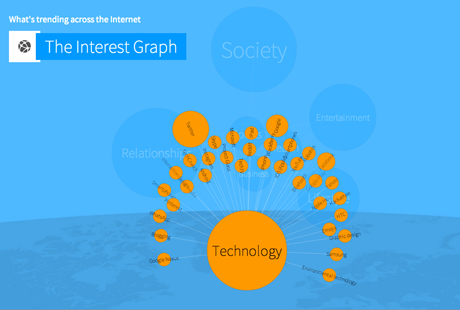
The homepage is dead. That was the consensus among many media commentators upon seeing the New York Times's leaked digital innovation report last week, a complex insight into the digital workings of the Times complete with a graph showing the 50 per cent fall in traffic to the homepage of NYTimes.com over the last two years.

Screenshots from Poynter.org, MartinBelam.com and Qz.com
Social media has become the biggest referrer of traffic to many publishers' sites, as readers' visits are based on links shared by their friends and contacts that genuinely interest them, rather than dropping onto a site, looking for news.
Having acquired personalisation company Gravity in January, AOL is looking to develop this personal angle across their sites – including TechCrunch, Engadget and The Huffington Post – to give readers the content they want in new and innovative ways.
"Conceptually, no two people have the same Facebook news feed," Josef Pfeiffer, director of product at Gravity, told Journalism.co.uk. "It's unique based on the friends you follow and the brands you engage with.
"A website could essentially be similar to that – where no two people could have the same version of a website, based on what we know about the content that they enjoy."
Readers may be arriving from a variety of different sources but if they are presented with a more relevant selection of articles across the site it will make for a better experience for readers and publishers alike, or so the theory goes.You'll have an entire home page or section page that is nuanced and individual for you, that would be different from everybody elseJosef Pfeiffer, Gravity
"If we can make [the site] unique for every user then we can hopefully drive more clicks, more engagement, more articles being read from that experience," Pfeiffer said.
Pfeiffer joined Gravity from the Wall Street Journal, where he lead the product team and used the software from a customer perspective. As the editorial output began to expand under Rupert Murdoch, he became concerned that, on the homepage, traditional readers looking for finance news may be put off by an influx of sport and fashion stories, or the reverse for new readers deterred by business news.
"Our theory was that it's kind of silly having this homepage and updating it every ten minutes," he said, "but every 10 to 15 million people that might be on the homepage at any given point in time are seeing the exact same set of headlines."
He began to think of the possibilities for personalisation, where editors could still pick the must-reads, but the other "40 to 50 stories below the top lead stories of the day you could personalise". Other topics and types of content will disappear depending on proven preferences, or develop over time as the software constructs a framework of readers' interests.
"You'll have an entire homepage or section page that is nuanced and individual for you, that would be different from everybody else. For instances like that, that's where we're more excited."
Gravity uses first-party cookies – very small data files generated by the site you are on – to identify returning readers and develop an idea of the types of articles and content that interest them most, based on their previous reading history.
For example, when someone visits the Huffington Post for the first time a cookie is "dropped", said Pfeiffer, with a randomly-generated user identification number that acts as a beacon for any subsequent visits. As a reader visits other Huffington Post URLs the cookie allows Gravity to develop a browsing history, or "click-stream", to build a picture of the types of content associated with that user ID.The stories that are presented to you are different to the stories that are presented to me and hopefully what that would give us is a more engaged audienceJimmy Maymann, The Huffington Post
"There's no way to tie that to the individual user through an IP address or email or zip code," Pfeiffer said, aware of the privacy-related issues around some uses of third-party cookies. "We just use that ID to basically track the articles they might read."
Gravity uses the data to create "interest graphs" to understand both individual reader habits and preferences but also wider reader trends around a website, like the Huffington Post, and the wider web as a whole.

Screenshot from Gravity.com of the web-wide interest graph, compiled by trawling the internet for new articles and analysing the content
"When I look at that on a macro level and we're producing on average 1,600 stories on a daily basis, it's interesting to see whether we're producing the right kind of stories," Jimmy Maymann, chief executive of The Huffington Post, told Journalism.co.uk.
From an editorial perspective, he hopes Gravity will give the Huffington Post a greater idea of what readers are interested in and what they are looking for from the publisher, but the "micro-level" experience for readers is regarded as equally important.
Publishers are used to creating a homepage that directs readers to different stories and parts of the site, said Maymann, but as more readers arrive at websites "through the side door" of social media, it becomes more important to create an "individualised experience" for each reader.
"So you arrive via a different side door than I do," Maymann continued. "You would see something different, the stories that are presented to you are different to the stories that are presented to me and hopefully what that would give us is a more engaged audience."
The initial experiments using Gravity software for "passive personalisation" on specific verticals of the Huffington Post site have led to between a "70 and 200 per cent increase" in click-through rates on suggested articles at the end or side of published content, said Maymann.
"So a significant increase," he said. "Personalisation is interesting because it's a great thing to do, both for the user, as they get a better experience, but also for the publisher because the content you produce can get in front of more people."
There is naturally a business angle involved too, Maymann admitted, as "people are more likely to click on content that is more relevant to them", but this is a "secondary concern" to improving the user experience.
"It's not so much about what your name is or where you live," he said. "That can be interesting but it's what is your behaviour online and what is that telling about you?
"What can we then learn from your behaviour and how can we then, as publishers, deliver a better experience? That's the next frontier in the personal internet and that is what Gravity is trying to help solve."
- Here is more from Journalism.co.uk on how different news sites are approaching personalisation.
Free daily newsletter
If you like our news and feature articles, you can sign up to receive our free daily (Mon-Fri) email newsletter (mobile friendly).
Related articles
- Seven tips for using LinkedIn as a freelance journalist
- Axel Springer CEO on OpenAI deal: 'We must protect intellectual property of news content'
- Audiences, AI and audio apps: five talking points from Perugia
- Journalists are happy to be disconnecting from platforms, should news organisations be worried?
- Protecting journalists on social media, with Valérie Bélair-Gagnon









